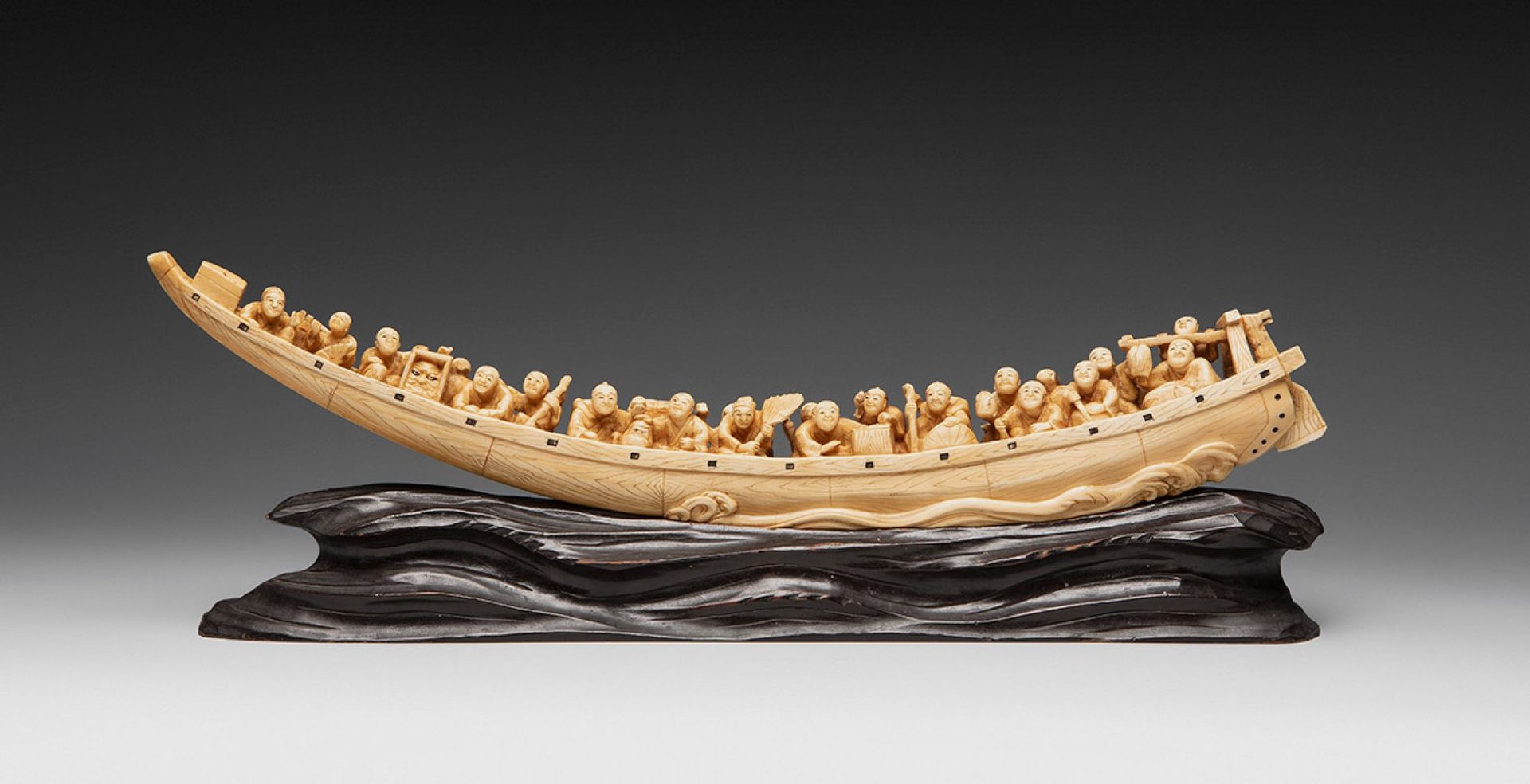Description
Ship with characters. Japan, Meiji period, late 19th - early 20th century. Signed with red wax seal on the reverse. On carved wooden base. Weight 1103 gr. The wax seal is broken. Enclosed are certificates from the Spanish Federation of Antique Dealers and the Guild of Antique Dealers of Catalonia, the last one updated in November 2022. Measurements: 9 x 50 x 5 cm. Carving made entirely in ivory from a single piece as revealed by its general shape, which follows the natural curve of the elephant's tusk. It is a representation of a group of fishermen plying the calm waters of the sea. The carving is remarkable for its marked preciosity and detail. The political and social situation in Japan during the Edo and Meiji periods was decisive in the development and evolution of ivory carving. In fact, the succession of social changes was directly and immediately reflected in the evolution of ivory carving. In the late 19th and early 20th centuries, ivory pieces are a faithful expression of the new Meiji era and contacts with the West. Indeed, extensive production was devoted to export to Europe and the United States. In the West, Japanese ivory surprised by its novelty, being especially admired for its purity of lines, its capacity for abstraction, its evocative power and the exquisiteness of its details. This piece can be classified as one of those made for foreign trade due to the enormous virtuosity with which it was carved. The Japanese craftsman worked for a specific clientele, who demanded pieces that conveyed calm and serenity. However, as the clientele changed, the product had to adapt to their different demands. Thus, artists modified the prevailing aesthetics of their pieces, since the European bourgeois of the late 19th and early 20th centuries demanded works of great decorativism and in which technical virtuosity was emphasised. The Japanese clientele, on the other hand, wanted technical skill to appear natural. Thus, in pieces such as the one we present here, the artist has reflected with naturalism and a very high level of detail both the facial features and the anatomies, clothing and expressions of the figures, also seeking to reflect the different qualities of the flesh tones, the fabrics, etc., with verisimilitude.
8
Ship with characters. Japan, Meiji period, late 19th - early 20th century. Signed with red wax seal on the reverse. On carved wooden base. Weight 1103 gr. The wax seal is broken. Enclosed are certificates from the Spanish Federation of Antique Dealers and the Guild of Antique Dealers of Catalonia, the last one updated in November 2022. Measurements: 9 x 50 x 5 cm. Carving made entirely in ivory from a single piece as revealed by its general shape, which follows the natural curve of the elephant's tusk. It is a representation of a group of fishermen plying the calm waters of the sea. The carving is remarkable for its marked preciosity and detail. The political and social situation in Japan during the Edo and Meiji periods was decisive in the development and evolution of ivory carving. In fact, the succession of social changes was directly and immediately reflected in the evolution of ivory carving. In the late 19th and early 20th centuries, ivory pieces are a faithful expression of the new Meiji era and contacts with the West. Indeed, extensive production was devoted to export to Europe and the United States. In the West, Japanese ivory surprised by its novelty, being especially admired for its purity of lines, its capacity for abstraction, its evocative power and the exquisiteness of its details. This piece can be classified as one of those made for foreign trade due to the enormous virtuosity with which it was carved. The Japanese craftsman worked for a specific clientele, who demanded pieces that conveyed calm and serenity. However, as the clientele changed, the product had to adapt to their different demands. Thus, artists modified the prevailing aesthetics of their pieces, since the European bourgeois of the late 19th and early 20th centuries demanded works of great decorativism and in which technical virtuosity was emphasised. The Japanese clientele, on the other hand, wanted technical skill to appear natural. Thus, in pieces such as the one we present here, the artist has reflected with naturalism and a very high level of detail both the facial features and the anatomies, clothing and expressions of the figures, also seeking to reflect the different qualities of the flesh tones, the fabrics, etc., with verisimilitude.
